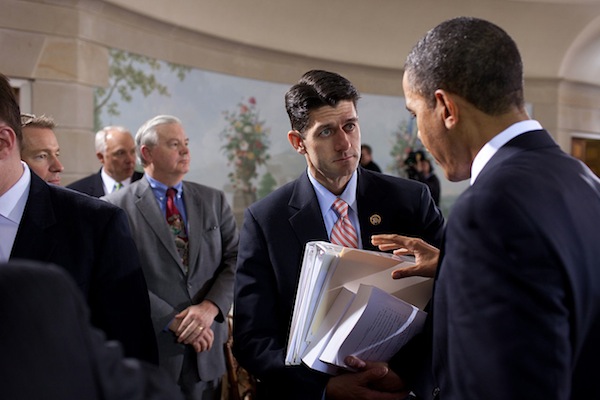
Photo by: White House
Rep. Paul Ryan, seen with President Obama, has targeted Food Stamp recipients who own cars.
When House Republicans voted last night to remove food stamps from the Congressional farm bill, they took the first step toward ending a 40-year-long compromise tying food aid to the poor (liked by big-city liberals) to farm subsidies (liked by rural conservatives).
And while some hunger experts say it’s about time—Joel Berg of the New York City Coalition Against Hunger wrote Wednesday he hoped for an end to “anti-hunger advocacy organizations [remaining] tied at the hip to the interests of massive agribusiness“—the farm bill squabble could end up leaving tens if not hundreds of thousands of New Yorkers without enough money to meet their daily expenses.
The heart of the House GOP’s action, it’s clear, is to enact cuts to the food stamp program (recently rechristened the Supplemental Nutrition Assistance Program, or SNAP), which has ballooned in recent years as millions of Americans were thrown out of work. The increased enrollment has especially galled Republicans like Wisconsin Rep. Paul Ryan, who yesterday called SNAP a “program in dire need of reform.” Ryan’s proposed reform: cutting off food aid to anyone with more than $2,000 in savings or a car worth more than $5,000.
Cutting food aid would have an especially big effect on poor New Yorkers, for whom it’s increasingly become a last-ditch lifeline as cash assistance—aka “welfare”—has dried up over the last two decades. (Food stamps can’t be used to pay electric bills or rent, but can free up other income to do so.) Since Congress revamped welfare in 1996, the number of New Yorkers getting cash aid has fallen from 1.1 million to 360,000; at the same time, rising poverty has driven the food stamp rolls from 1.4 million to a record of nearly 1.9 million. The federal government’s new supplemental poverty measure—intended to remedy the flaws in the standard and very dated poverty line—found that food stamps lift 4.7 million Americans out of poverty; if similar numbers hold for the city, about 166,000 New Yorkers are kept out of poverty solely by food stamps.
Whether the proposed GOP cuts will go through remains uncertain: The SNAP-free House farm bill still needs to be reconciled with the Senate version by the end of September, and as Berg tells City Limits, “I have no clue what happens next. Anyone who tells you they know is a fool or a liar.”
But some form of new limits on food aid seems inevitable. Another provision—approved by the House last month, but currently tabled along with the rest of SNAP—would establish welfare-reform-style work requirements, cutting off food aid to any families where parents weren’t working 20 hours a week. The Democratic-controlled Senate, meanwhile, already voted to end food aid to up to half a million people (200,000 of them New Yorkers) who qualify for SNAP by getting federal low-income heating assistance, as well as banning for life the families of anyone who had ever been committed of murder, child sexual abuse, or violent sexual assault.
With the same conservative think tanks that spearheaded welfare reform already setting their sights on disability coverage, yesterday’s food stamp vote could be just the start of things to come.








